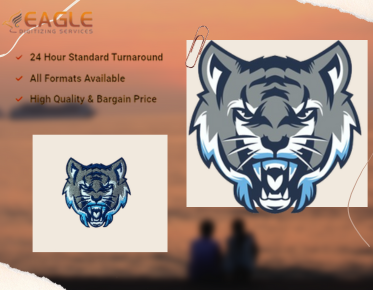Create Magic with Intricate Vector Illustration Techniques
Vectorart is a powerful tool for graphic designers, artists, and illustrators who seek precision, flexibility, and endless creative possibilities. Whether you're crafting logos, illustrations, or web designs, mastering advanced vector techniques can elevate your work from simple designs to stunning masterpieces. In this guide, we’ll explore how advanced vector techniques bring life to your designs, allowing for more intricate, professional, and eye-catching artwork.
Why
Vector Techniques Matter for Stunning Designs
Vector techniques
matter because they enable designers to create artwork that is not only
visually captivating but also scalable, editable, and precise. Unlike raster
images, which can lose quality when resized, vector art remains crisp and clear
no matter how large or small you make it. This inherent quality allows
designers to work confidently, knowing their designs will always look polished,
regardless of the medium or scale.
Advanced vector
techniques take this precision to the next level. By delving into the details
of paths, shapes, and gradients, you can transform flat, lifeless designs into
multi-dimensional works of art. The result? Designs that capture attention,
evoke emotion, and convey complex ideas with clarity and elegance.
The
Basics: What Makes Vector Art Unique
At its core,
vector art is made up of paths defined by mathematical equations. These paths,
known as "vectors," are composed of anchor points connected by lines.
Unlike pixel-based images, which are made up of tiny squares (pixels), vector
graphics rely on mathematical formulas to define the shapes and lines, allowing
for infinite scalability without any loss of quality.
What makes vector
art unique is its ability to be manipulated easily. Whether you’re scaling an
illustration to the size of a billboard or shrinking it to fit on a business
card, the integrity of the design is always maintained. This flexibility makes
vector art an ideal medium for a wide range of applications, from digital
illustrations to printed materials.
Understanding
the Power of Scalability
One of the most
powerful advantages of vector art is its scalability. Because vector images are
based on mathematical formulas, they can be resized infinitely without losing
any quality. This means you can create a design on a small canvas and later
scale it up for large-format prints, signage, or even billboards, with no
pixelation or distortion.
Scalability is
especially important for logos and branding, where consistency across various
platforms and sizes is crucial. From website headers to promotional
merchandise, vector files ensure your designs look crisp and professional every
time, no matter where they appear.
Why Intricacy is the Key to Mesmerizing Designs
Intricacy in
design refers to the level of detail, complexity, and fine craftsmanship that
elevates an artwork beyond the ordinary. In vector illustrations, intricacy
allows you to create a sense of realism, depth, and sophistication. By
incorporating delicate details—such as subtle gradients, small patterns, and
finely tuned linework—you can capture the viewer’s attention and engage them on
a deeper level.
Advanced vector techniques enable you to achieve this level of
intricacy, allowing your designs to stand out in an increasingly crowded visual
world. When every element is carefully considered, from the smallest stroke to
the most complex shape, your artwork becomes a rich tapestry of creativity that
mesmerizes the viewer.
Getting
Started with Advanced Tools
Before diving
into advanced vector techniques, it's important to familiarize yourself with
the tools at your disposal. Most vector work is done using programs like Adobe
Illustrator, CorelDRAW, or Affinity Designer. These powerful design tools are
equipped with a vast array of features that allow you to create precise,
detailed vector art.
To get started,
it’s essential to learn the ins and outs of your chosen software, from basic
tools like the selection tool and pen tool to more advanced features like
gradients, mesh tools, and pattern creation. Mastering these tools will lay a
solid foundation for experimenting with advanced techniques.
Essential
Software for Advanced Vector Design
While Adobe
Illustrator is the industry standard for vector design, there are several other
software options to consider, each with its unique features and strengths.
CorelDRAW, for example, is a popular choice for graphic designers working in
print. Affinity Designer has gained traction for its affordable pricing and
seamless workflow between raster and vector art.
The key to
choosing the right software is understanding your specific needs and workflow.
Whether you’re designing for digital or print, ensure the software you select
offers the tools and flexibility to execute your vision with precision.
Setting
Up Your Workspace for Creativity
An organized and
comfortable workspace is crucial for maintaining focus and fostering
creativity. Ensure your digital workspace is set up to streamline your process.
Use artboards to organize your designs, keep your layers neatly grouped, and
utilize shortcuts for quick access to frequently used tools.
For physical
workspace setup, ensure your desk is ergonomically designed, with a comfortable
chair and plenty of space for your equipment. An organized, well-lit, and
distraction-free environment allows your mind to focus solely on the art, which
is key when you're working with intricate details.
Must-Have Shortcuts and Techniques for Efficiency
Efficiency is key
when it comes to creating detailed vector art.
Learning keyboard shortcuts and mastering time-saving techniques can
drastically improve your workflow. For example, using the "Ctrl + Z"
command for undoing mistakes, "Shift" for perfect proportions, and
"Alt" for duplicating objects can save you time and allow for
smoother design processes.
In addition to
shortcuts, learn how to use advanced features like smart guides, snapping, and
aligning tools to ensure precision and consistency across your designs.
Mastering
the Art of Intricate Details
Intricate details
are what make vector illustrations stand out. By learning how to create tiny,
precise elements like ornate borders, detailed textures, and finely crafted
patterns, you can elevate your designs from basic to breathtaking. Focus on
refining every curve, line, and corner, ensuring that each detail contributes
to the overall composition.
Advanced
techniques like the use of compound paths, pathfinder tools, and shape-building
tools can help you achieve the perfect level of detail, adding a sense of
complexity without overwhelming the design.
Creating
Perfectly Balanced Linework
Linework is a
fundamental aspect of vector design. Whether it’s for logos, illustrations, or
iconography, creating clean, balanced lines is crucial to achieving professional
results. Use the Pen tool to create smooth, fluid curves, and adjust anchor
points to ensure your lines are consistent in thickness and proportion.
Experiment with
line weights, adding subtle variations to give your work a dynamic feel.
Remember, perfect linework is not about creating straight lines all the
time—slight imperfections can add personality and energy to your designs.
How
to Add Texture Without Losing Precision
Texture in vector
art doesn’t have to mean rough, pixelated elements. In fact, you can add a
sense of texture and depth while maintaining the precision of your vectors.
Experiment with subtle gradients, halftone patterns, or custom brushes to
create tactile effects that give your designs richness and dimension.
By layering
textures with care and integrating them into your compositions, you can add
complexity and realism without sacrificing the clarity and sharpness that make
vector art so visually appealing.
The
Role of Gradients in Adding Depth
Gradients are a
powerful tool for adding depth and dimension to your vector artwork. By
transitioning from one color to another, gradients create a sense of light,
shadow, and volume. Whether you're creating a soft background or adding subtle
shading to an object, gradients can help your designs feel more
three-dimensional.
Mastering
gradient meshes and multi-stop gradients allows for more nuanced shading and
lighting effects, which can add life and realism to your designs.
Mastering
Shapes: From Simple to Complex
The ability to
work with simple and complex shapes is at the heart of advanced vector
techniques. Starting with basic shapes like circles, squares, and triangles,
you can combine and manipulate these elements to form more intricate designs.
Learn how to use
the shape builder tool, pathfinder tool, and other advanced shape-modifying
techniques to seamlessly create complex forms. This allows you to break down
complicated designs into simpler components, making it easier to build and
refine your work.
Advanced
Techniques to Elevate Your Vector Skills
To truly elevate
your vector design skills, experiment with advanced techniques like creating
custom brushes, designing with symmetry, and mastering the gradient mesh tool.
These advanced tools enable you to push the boundaries of what’s possible in
vector art, allowing you to add even more realism and creativity to your
designs.
Using
Clipping Masks for Layered Perfection
Clipping masks
are an essential tool for creating layered, complex designs in vector art. By
masking certain areas of an image, you can create the illusion of depth and
dimensionality, allowing you to layer shapes and images in a way that’s
visually captivating.
Use clipping
masks to create intricate compositions, such as overlapping shapes, complex
patterns, and multi-layered illustrations. They allow for greater flexibility
in design while maintaining a clean, professional finish.
Mastering
the Pen Tool Like a Pro
The Pen tool is
arguably the most important tool for any vector artist.
With it, you can draw precise paths, adjust curves, and manipulate anchor
points to create clean, sharp lines and shapes. Mastering the Pen tool allows
you to work with unparalleled precision and control, which is vital for
intricate designs.
To become
proficient, practice creating curves and straight lines, and learn how to
adjust bezier handles to perfect your shapes. The more comfortable you are with
the Pen tool, the more freedom you’ll have in creating detailed, complex
designs.
The Power of Pathfinder for Seamless Shapes
The Pathfinder
tool is an essential feature for anyone looking to work with intricate shapes.
It allows you to combine, subtract, intersect, and exclude paths with
precision, creating seamless designs that are both efficient and visually
striking.
Learning to use
Pathfinder effectively can simplify your design process, allowing you to
quickly manipulate and modify shapes to fit your needs without cluttering your
workspace.
Custom
Brushes: Your Secret Weapon for Unique Designs
Custom brushes
are an excellent way to add a personal touch to your vector artwork. Whether
you’re designing textures, patterns, or decorative elements, custom brushes
allow you to create unique effects that stand out.
From organic, hand-drawn effects to geometric patterns, custom brushes
offer endless possibilities for adding flair and originality to your work.
Adding
Personality to Your Designs
Vectordesigns can sometimes feel sterile or
mechanical, but with the right techniques, you can infuse your artwork with
personality and charm. Whether it’s through whimsical linework, bold color
choices, or quirky details, there are endless ways to make your designs more
relatable and engaging.
Focus on adding
touches that reflect your unique style—whether that’s through playful shapes, irregular
patterns, or personalized illustrations. It’s these little details that make a
design truly memorable.
.png)


